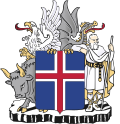 |
|---|
Parliamentary elections were held in Iceland on 10 September 1908, alongside a referendum on prohibition. [1]
 |
|---|
Parliamentary elections were held in Iceland on 10 September 1908, alongside a referendum on prohibition. [1]
The Althing was dissolved by King Frederik VIII in the early spring in order to elect a new parliament that would vote on a draft status law that would define the position of Iceland in the Danish realm. [2] The election campaign was one of the acrimonious in Icelandic political history due to the controversial nature of the draft. [2] The opposition was led by Skúli Thoroddsen, a member of the Independence Party. [3]
The 36 members of the Althing were elected from a mix of single-member and two-member constituencies. [4] The elections were the first to take place since changes to the electoral system in 1904; they were the first to be held using the secret ballot, [5] and also saw the three-round majoritarian system replaced by plurality voting as multiple rounds of voting on the same day were no longer possible. [4] The tax qualification for voting was also reduced, increasing the proportion of people able to vote to around 14% of the population, [4] up from 7,786 in 1903 to 11,726. [6]
Candidates opposed to the draft law won a landslide majority, whilst voter turnout was 72.4%, nearly 20% more than the 1903 elections. [6] As a result, the law was voted down in 1909, [2] resulting in the resignation of Minister for Iceland Hannes Hafstein. [3]